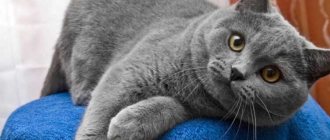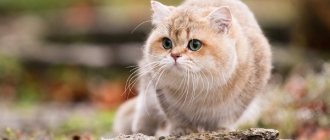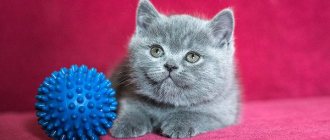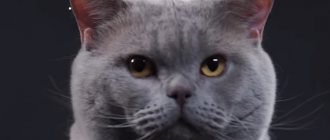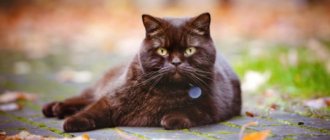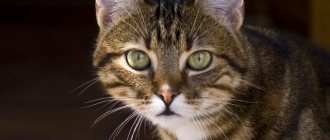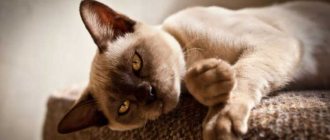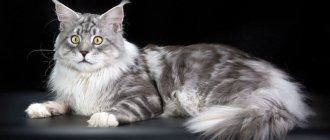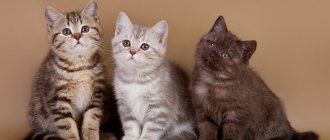Review author: “ZooVita”
The main distinguishing feature of this cat breed, from which it got its name, is its short hair, the appearance of which can be seen in the photo of a British Shorthair cat. There is no exact information about the homeland of this beautiful cat.
According to some sources, she appeared in France, while other sources claim that she is a descendant of Egyptian cats. The first exhibition at which this breed was presented took place in England in 1871.
After this exhibition, breeders and cat lovers paid attention to the British Shorthair, being impressed by the beauty of its dense coat.
The cat gained worldwide fame and distribution only in the 20th century, and was brought to the Russian Federation in 1980. Currently, the breed is popular all over the world.
Appearance of the British Shorthair cat
The description of the British Shorthair cat can begin with the fact that despite its rather large size, it has truly feline grace and elegance. This breed attracts with its beautiful, deep look and velvety coat, which is very pleasant to the touch and appearance.
If necessary, the British Shorthair can be a good hunter. The weight of representatives of the breed can range from four to eight kilograms.
He has fairly broad shoulders, a chest and a powerful body. The round and wide head has a short nose. The eyes are also round, the color of which depends on the type of breed and can be orange, blue or green.
The paws are small, but massive with thick claws. The tail has a rounded end, thickened at the base. The ears of British Shorthairs should be straight and erect, this indicates the purebred of the individual. The coat has a dense undercoat and is short and dense.
How to choose a kitten
If you want to purchase a purebred real British dog, then you should pay attention to the characteristics of the breed (the standards of which were approved back in 1982).
These standards include:
- strong muscular body;
- powerful legs, like those of an exotic ;
- massive round head on a short powerful neck;
- straight, wide and slightly shortened nose, without a stop, but pronounced towards the forehead;
- round muzzle without indentations (pinch is not allowed), well-developed chin, round, wide-set eyes;
- rounded, wide-set ears (the height of which should not exceed their width);
- straight (medium in length, but wide) tail with a rounded tip;
- short, dense wool with a plush-like texture;
- fold of skin around the head.
A British kitten's walk should be full of vivid impressions
In addition to the characteristics of the breed, you should definitely pay attention to the documents and living conditions of the kittens.
If the breeders do not treat the animals properly (the place is not clean, has a characteristic unpleasant smell, the animal is given cheap food, it is kept in a cage), turn around and go to another place.
It is worth paying attention to the parents of the kittens (you will be able to understand what your “plush” will be like). Look at the color, weight and other features.
If your Briton is a ginger cat , then his offspring will be the same.
Please also pay attention to the fact that kittens should not be purchased before 12 weeks of age, as they still need maternal care.
There must be something edible in this basket, well, at least a sausage!
Types of colors of the British Shorthair cat
The most common color is blue. But the colors of the British Shorthair cat are very diverse:
Solid color
The cat's fur, like its skin, should be the same color. The most widely represented color is blue, but other options are possible: black, lilac, chocolate, red and white. The rarest solid colors of the British Shorthair cat are: cinnamon and fawn.
The black color combines surprisingly beautifully with yellow eyes. The lilac color is artificially bred. The value of a chocolate-colored cat becomes higher depending on the intensity of its shade.
In short-haired dogs with a red color, the intense color is considered valuable. The White British Shorthair cat is very difficult to breed and has a high risk of giving birth to offspring with defects.
The rarest color of the cat's color - "Cinnamon" - is very much appreciated by lovers of the breed. But the rarest of the colors is considered to be “Faun”. This color is valuable because it makes it possible, during breeding, to produce offspring of new light shades.
Tortoiseshell color
Basically, females are endowed with this complex and beautiful color, while males, if they have a tortoiseshell color, are sterile. Particularly appreciated is the presence of red or cream shades on the cat’s face in this color.
Silver and golden color
Cats with such a magnificent color are also called British chinchillas. The British species with this coloring is one of the rare and most expensive.
Eye color typical for silver cats: blue, lilac or green. Individuals with a golden color are considered defective if there is a gray undercoat.
Color Point
The similarity of the British Shorthair Color Point with cats of the Siamese breed is due to the characteristic coat colors: basic white in combination with black, chocolate or red.
Tabby
An amazing feature of the British Tabby color is the presence of patterns on the coat in the form of symmetrical stripes and spots on any non-primary color. Tabby cats are very similar to tigers or leopards.
"Whiskas"
A valuable type of color, characterized by clear stripes covering the entire body of the cat, is the Whiskas color. The pattern should be as clear and contrasting as possible.
Bicolor or "Harlequin"
The peculiarity of the color is the presence of two colors, the predominant of which is white. The additional color may not be uniform and may have patterns.
British vs Scots
The British plush kitten should in no case be confused with the Scottish one. Britons are massive, large animals with short legs and a thick tail. The Scottish kitten will grow up to be thinner-legged, its tail will be longer, and its cheeks will be much smaller. The British Shorthair is a purebred, naturally healthy, moderately aggressive cat breed that has retained all its hunting skills, and the shorthaired plush Scots are the product of the genetic efforts of lovers of a soft and fluffy bundle of warmth in their arms.
The short-haired plush Scottish cat is completely devoid of aggression at the genetic level, she does not know how to hunt and is unlikely to survive if she gets lost on the streets of the city. Scottish cats are distinguished by their affectionateness, sociability, even tenderness; they get along with everyone equally well and are simply ideal for a family with noisy and loud children, where a true Briton would not be very comfortable. Therefore, there is no need to take him into such a family.
Personality traits of the British Shorthair cat
Despite the fact that British Shorthair cats tolerate loneliness quite painlessly, they yearn for an absent owner. Preferring independence, cats of this breed become attached to one person.
The cat prefers to avoid strangers, occasionally responding to obsessive attention with aggression. Possessing self-esteem, representatives of the British Shorthair are extremely restrained and not intrusive.
They have a minimal need for affection from their owner. He has a calm disposition and even in the event of aggression, he does not immediately use his claws, but only warns with a blow of a soft paw.
If there is a special claw scratcher, the cat, due to its good manners, will not damage the furniture. She is very selective in choosing her favorite places, which are always central in the home.
Representatives of the breed are very playful and prefer to have several toys. They respond well to training at an early age; it is almost impossible to retrain an adult cat.
The “British” devote quite a lot of time to their appearance, carefully licking themselves throughout the day. There are no problems when toilet training a cat, since this breed is very clean and the only nuance may be the individual selection of litter for the tray.
Health
Considering the efforts of the breeders, the British were in good health.
These cats are prone to obesity and tearfulness, but otherwise are susceptible to the same diseases as cats of other breeds.
Characteristic diseases
If you do not properly care for your pet: feed it poorly, do not provide proper care and do not take care of its mental state, then it may develop one of the following diseases:
- KSD, cystitis, nephrosis and other diseases of the genitourinary system;
- Bronchitis, rhinitis and other respiratory diseases;
- inflammation of the spinal cord and neuroses;
- stomatitis, pharyngitis, ulcer
- and many other diseases.
British kittens are excellent camouflages
Vaccinations
The Briton needs to have some vaccinations , before which it is important to give the kitten anthelmintic drugs.
- Produced in 10-12 weeks. This is a rabies vaccine (trivalent). It repeats after 3 weeks.
- The rabies vaccination is given after changing teeth and is repeated annually.
British cat helps prepare for Easter
All manipulations must be noted in the passport. When buying a kitten, you need to check them
Nutrition and care of the British Shorthair cat
Although caring for a British Shorthair cat is not tedious, it does require some time. To maintain the appearance of the coat, it is necessary to comb the cat several times a week. You should not bathe your pet more than twice a year. You need to clean your ears and trim your nails at least once a month.
The diet of this breed, like others, must be balanced and contain all the necessary vitamins and minerals. Proper nutrition will help maintain your cat's health and appearance at a high level.
It is acceptable to feed your pet prepared food, but preference should be given to reputable manufacturers. Foods containing salt and sugar can be harmful to your cat.
